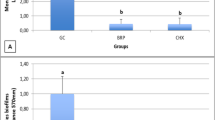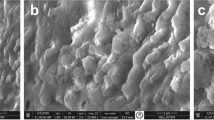Abstract
The aim of the present study was to evaluate the effectiveness of chlorhexidine digluconate (CHX) and commonly used mouthrinses to single- and poly-species biofilms by S. mutans, S. aureus and P. aeruginosa, on titanium discs of grade IV. The formation of single- and poly-species biofilms at 16.5, 40.5 and 64.5-h incubation on titanium surface was evaluated by plate count (CFU ml−1) before and after exposure to CHX and four mouthrinses (Curasept, Listerine, Meridol and Buccagel) and expressed as percentage of Inhibitory Activity (IA%). The application of the different anti-plaque formulations on biofilm can reduce the adhesion of bacteria to titanium surface with different degrees. The higher efficacy was observed for Listerine that shows IA% = 100 on the biofilm formed by S. mutans at 16.5 h. Log count of CFU was dependent to culture time and four mouthrinses for S. mutans and S. aureus, whilst was not dependent to culture time but to mouthrinses for P. aeruginosa. In general, the efficacy was particularly lesser to poly-species biofilms; no statistical differences were evidenced between all the mouthrinses and CHX as control group. The tested mouthrinses, compared to reference CHX 0.2%, have demonstrated a significant lower antibacterial activity than Listerine towards the experimental biofilms. This “in vitro” biofilm model should prove extremely useful for pre-clinical testing of anti-plaque agents, which inhibit biofilm formation, can prevent subsequent implant failure.

Similar content being viewed by others
References
Abrahamsson I, Berglundh T, Lindhe J (1998) Soft tissue response to plaque formation at different implant systems. A comparative study in the dog. Clin Oral Implants Res 9:73–79
Anderl JN, Zahller J, Roe F, Stewart PS (2003) Role of nutrient limitation and stationary- phase existence in Klebsiella pneumoniae biofilm resistance to ampicillin and ciprofloxacin. Antimicrob Agents Chemother 47:1251–1256
Brown MRW, Allison DG, Gilbert P (1988) Resistance of bacterial biofilms to antibiotics: a growth-rate related effect. J Antimicrob Chemother 22:777–783
Ciancio SG (2000) Antiseptics and antibiotics as chemotherapeutic agents for periodontitis management. Compend Contin Educ Dent 21:59–78
Drake DR, Paul J, Keller JC (1999) Primary bacterial colonization of implant surfaces. Int J Oral Maxillofac Implants 14:226–232
Elter C, Heuer W, Demling A, Hannig M, Heidenblut T, Bach FW, Stiesch-Scholz M (2008) Supra- and subgingival biofilm formation on implant abutments with different surface characteristics. Int J Oral Maxillofac Implants 23:327–334
Emilson CG (1977) Susceptibility of various microorganisms to chlorhexidine. Scand J Dent Res 85:255–265
Gilbert P, Das JR, Foley I (1997) Biofilm susceptibility to antimicrobials. Adv Dent Res 11:160–167
Grosgogeat B, Reclaru L, Lissac M, Dalard F (1999) Measurement and evaluation of galvanic corrosion between titanium/Ti6A14V implants and dental alloys by electrochemical techniques and auger spectrometry. Biomaterials 20:933–941
Guggenheim B, Giertsen E, Schupbach P, Shapiro S (2001) Validation of an in vitro biofilm model of supragingival plaque. J Dent Res 80(1):363–370
Lamster IB (2006) Antimicrobial mouthrinses and the management of periodontal diseases. Introduction to the supplement. J Am Dent Assoc 137(suppl):5S–9S
Moreira MR, Ponce AG, del Valle CE, Roura SI (2005) Inhibitory parameters of essential oils to reduce a foodborne pathogen. LWT-Food Sci Technol 38:565–570
Quirynen M, De Soete M, van Steenberghe D (2002) Infectious risks for oral implants: a review of the literature. Clin Oral Implants Res 13:1–19
Quirynen M, De Soete M, Dierickx K, Van Steenberghe D (2001) The intraoral translocation of periodontopathogens jeopardise the outcome of periodontal therapy. A review of the literature. J Clin Periodontol 28:499–507
Rasooli I, Shayegh S, Taghizadeh M, Darysh S, Astaneh A (2008) Phytotherapeutic prevention of dental biofilm formation. Phytother Res 22:1162–1167
Saginur R, Stdenis M, Ferris W, Aaron SD, Chan F, Lee C, Ramotar K (2006) Multiple combination bactericidal testing of staphylococcal biofilms from implant-associated infections. Antimicrob Agents Chemother 50(1):55–61
Shapiro S, Giersten E, Guggenheim B (2002) An in vitro oral biofilm model for comparing the efficacy of antimicrobial mouthrinse. Caries Res 36:93–100
Sisson CH, Wong L, Cutress TW (1995) Patterns and rates of growth of microcosm dental plaque Biofilms. Oral Microbiol Immunol 10:160–167
Stanley A, Wilson M, Newman HN (1989) The in vitro effects of chlorhexidine on subgingival plaque bacteria. J Clin Periodontol 16:259–264
Stewart PS (2003) Diffusion in biofilms. J Bacteriol 185:1485–1491
Takeuchi Y, Guggenheim B, Filieri A, Baehni P (2007) Effect of chlorhexidine/thymol and fluoride varnishes on dental biofilm formation in vitro. Eur J Oral Sci 115:468–472
Tassou C, Koutsoumanis K, Nychas GJE (2000) Inibition of Salmonella enteritidis and Staphylococcus aureus in nutrient broth by mint essential oils. Food Res Int 33:273–280
Yao Y, Berg EA, Costello CE, Troxler RF, Oppenheim FG (2003) Identification of protein components in human acquired enamel pellicle and whole saliva using novel proteomics approaches. J Biol Chem 278:5300–5308
Author information
Authors and Affiliations
Corresponding author
Rights and permissions
About this article
Cite this article
Baffone, W., Sorgente, G., Campana, R. et al. Comparative Effect of Chlorhexidine and Some Mouthrinses on Bacterial Biofilm Formation on Titanium Surface. Curr Microbiol 62, 445–451 (2011). https://doi.org/10.1007/s00284-010-9727-x
Received:
Accepted:
Published:
Issue Date:
DOI: https://doi.org/10.1007/s00284-010-9727-x




